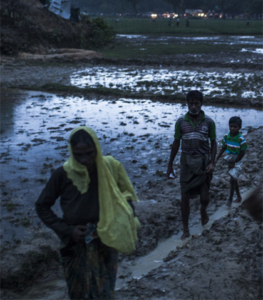Rohingya crisis – three years on
Three years into the Rohingya refugee crisis, men women and children – driven from their homes in Myanmar into camps across the border in Bangladesh – are even more vulnerable than ever, UN agencies say.
According to the UN World Food Program (WFP), almost all refugees remain entirely dependent on food assistance to survive.
 “The availability of foods in camps, outside of WFP assistance, has been shrinking and prices rising,” a spokesperson for the UN agency said.
“The availability of foods in camps, outside of WFP assistance, has been shrinking and prices rising,” a spokesperson for the UN agency said.
“Disrupted supply chains due to COVID-19 lockdown measures are also affecting availability of fresh food, the WFP said.
Earlier this month, almost 300 Rohingya refugees – two thirds of them women and children – arrived in Aceh, Indonesia, after seven months at sea and having been refused permission to land by several countries.
The UN refugee agency said test for COVID-19 had all come back negative but three of the Rohingya had died from other causes and many other were weak and in poor health.
More than 860,400 Rohingya refugees are living in exile in the Cox’s Bazar District of Bangladesh.
Children make up 52 per cent of the total refugee population and women and girls make up 51 per cent.
The UNHCR says the humanitarian situation in Cox’s Bazar has been worsened by the spread of the COVID-19 pandemic and only critical aid services such as health and nutrition are possible in the camps at the moment.
Aid agencies fear that an uncontained outbreak of COVID-19 in the refugee camps – which are among the largest and most overcrowded in the world – could be devastating.
They say that with several hundred thousand people living in an area of just 13 square kilometres, social distancing is almost impossible.
In addition to COVID, relentless rain and hazardous weather have added to the challenges. According to humanitarian reports, over 100,000 refugees have been affected due to the heavy monsoon rains, this year that destroyed shelters and washed away crops.
The UN Children’s Fund UNICEF says the lives of Rohingya refugee children have also been severely hit by the pandemic.
Schools in the camps have been closed since March, as is the case in the rest of Bangladesh, keeping more than 300,000 children and adolescents away from learning.
“Rohingya refugee children need opportunities to develop knowledge and skills for their future. That in turn will enable them to contribute to peace and stability,” a UNICEF spokesperson said.
But, in spite of the incredibly difficult circumstances, the refugee population is actively participating in response efforts to prevent and manage the threat of COVID-19, the UN says.
With the reduction of humanitarian workers in the camps to limit the spread of COVID-19, humanitarian organisations and UN agencies have established new ways to deliver critical services and raise awareness on the disease, said UNICEF. And Rohingya volunteers and Bangladeshi personnel have been essential to such efforts.
In July, UNICEF and partners launched a door-to-door Vitamin A supplement campaign. Rohingya volunteers proved vital in reaching 154,000 children aged 6 months to 5 years. The campaign covered 97 per cent of the target children.
The Rohingya refugee crisis began in August 2017, following attacks on remote police outposts in northern Myanmar by armed groups alleged to belong to the community.
These were followed by systematic counter attacks against the minority, mainly Muslim, Rohingya, which human rights groups have said amounted to ethnic cleansing.
In the weeks that followed, over 700,000 Rohingya – the majority of them children, women and the elderly – fled their homes for safety in Bangladesh, with little more than the clothes on their backs.
Prior to the mass exodus, well over 200,000 Rohingya refugees were sheltering in Bangladesh as a result of earlier displacements from Myanmar.












